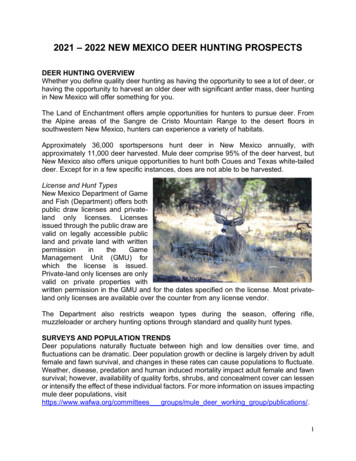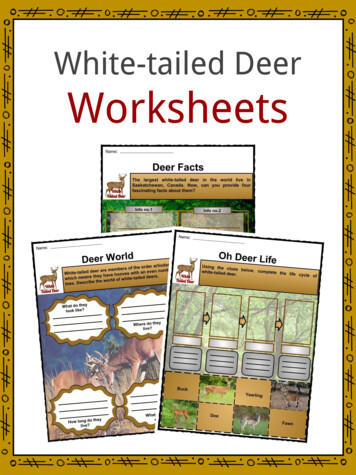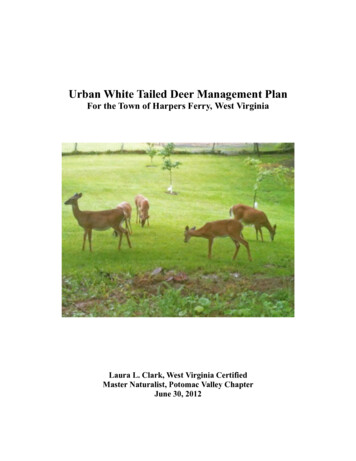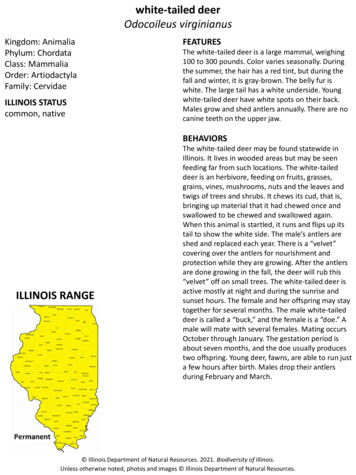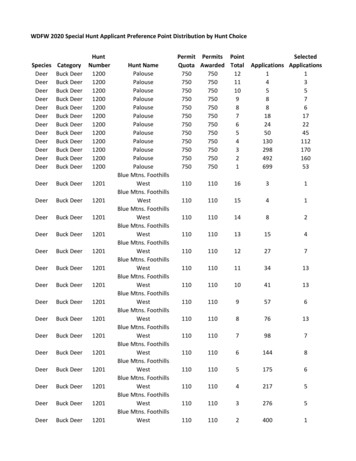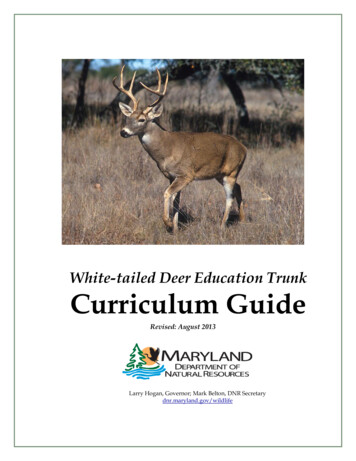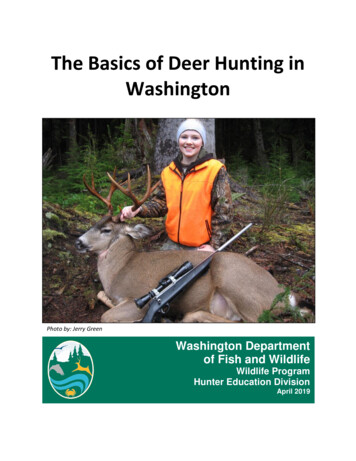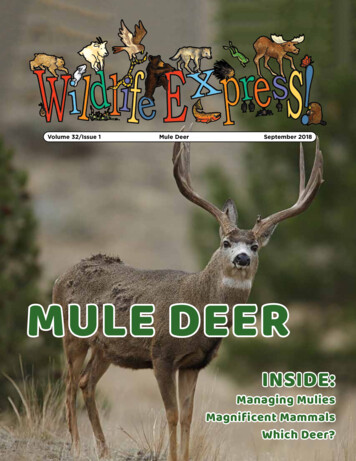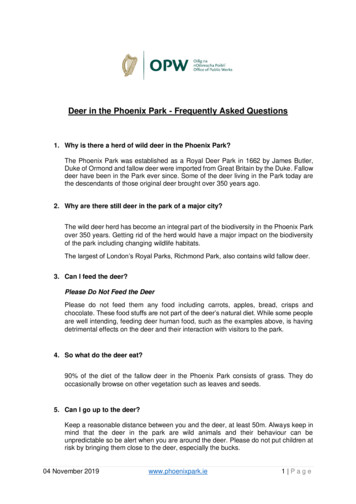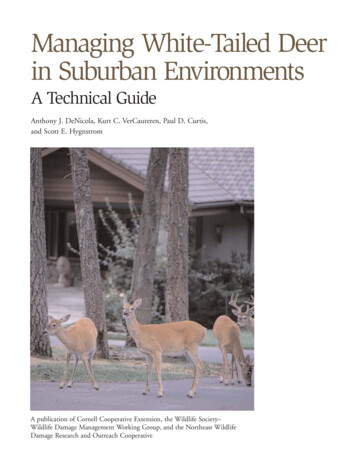
Transcription
Managing White-Tailed Deerin Suburban EnvironmentsA Technical GuideAnthony J. DeNicola, Kurt C. VerCauteren, Paul D. Curtis,and Scott E. HygnstromA publication of Cornell Cooperative Extension, the Wildlife Society–Wildlife Damage Management Working Group, and the Northeast WildlifeDamage Research and Outreach Cooperative
AcknowledgmentsAnthony J. DeNicolaWhite Buffalo, Inc.54 Grandview AvenueHamden, CT 06514Kurt C. VerCauterenUnited States Department of AgricultureNational Wildlife Research Center4101 LaPorte AvenueFort Collins, CO 80521-2154Paul D. CurtisCornell Cooperative ExtensionDepartment of Natural ResourcesFernow HallIthaca, NY 14853-3001Scott E. HygnstromSchool of Natural Resource SciencesUniversity of NebraskaLincoln, NE 68583The Suburban Deer Technical Committee of the WildlifeSociety’s Wildlife Damage Management Working Groupprovided support and input for development of this guide.We especially acknowledge the efforts of A. Smith. Theguide was reviewed by Wildlife Society Council membersR. Brown, T. Franklin, J. Miller, J. Organ, N. Silvy, and R.Warren. The Wildlife Society, Cornell CooperativeExtension, and the Northeast Wildlife DamageManagement Research and Outreach Cooperative provided financial support for the publication of this document.Additional reviews were contributed by B. Bazartseren, R.Christoffel, D. Cuddy, D. Etter, H. Kilpatrick, and A.Wywialowski. D. J. Smith assisted with the developmentof the Supplies and Materials Section. Photo credits: B.Bazartseven (Fig. 19); T. Christie (cover photo); G. Curtis(Figs. 1, 9, 13); P. Curtis (Figs. 10, 11, 12, 14, 15, 18); A.DeNicola (Figs. 3, 4, 6, 17); M. Fargione (Fig. 8); M.Lowery (Figs. 5, 7); Pfizer (Fig. 2); R. Pooler (Figs. 16, 20).ISBN 1-57753-296-1
ContentsAbout This Guide2Introduction3Biology of the White-Tailed DeerDescription and General BehaviorHabitat and HabitsReproductionBiological Carrying CapacityHome Range and MovementsMortality6667778Regulations Regarding White-Tailed Deer9Deer Ecology and Management10Human Dimensions and Deer Management 11Developing an Integrated ManagementStrategy13Estimating Deer Population Size14Management TechniquesNonlethal Management OptionsHabit ModificationBan on Deer FeedingUnpalatable Landscape PlantsRepellentsSupplemental FeedingFencingHazing and Frightening TechniquesDogs as a DeterrentApproaches for Minimizing DeerVehicle CollisionsRoadside ReflectorsWildlife Warning WhistlesWarning SignsFencingVegetation Management, Speed Limits,and Public AwarenessPopulation Reduction OptionsTrap and TranslocateTrap and EuthanasiaSharpshootingControlled xperimental Deer ManagementFertility Control AgentsRegulatory and Permit Requirements forAntifertility ResearchAntifertility Agents under InvestigationDelivery Methods2929293030Summary32References33Appendix A. Deer Damage ControlSupplies and MaterialsHabitat ModificationExclusionFrightening DevicesRepellentsLive CaptureFertility ControlShooting ServicesShooting Supplies414141444750505051Appendix B. Resource ContactsState Wildlife Agency Phone Numbers5252
About This GuideConsiderable confusion and controversy surroundwhite-tailed deer management in suburban environments. Availability, efficacy, and humaneness of management options are often misunderstood. As a result,opinions and sentiments differ regarding the management of suburban deer populations. This booklet pro-2 Managing White-Tailed Deer in Suburban Environmentsvides an overview of these complex issues and discusses the usefulness of various management options forresolving localized deer-human conflicts. The manualis intended for professional biologists and managers,community leaders, and others involved or concernedwith suburban deer management.
IntroductionWhite-tailed deer (Odocoileus virginianus) are probably the best known and most widespread large mammal in North America. Recognized as a valuable natural resource, deer are a welcome sight until conflictsarise with homeowners, farmers, foresters, motorists,gardeners, or landscapers. Their adaptability, acutesenses, and other physical attributes allow them toflourish in metropolitan suburbs as well as in thewilderness. Locally overabundant deer populations arebecoming more prevalent, especially where they arenot actively managed. This typically occurs in suburban communities or on corporate or protected government properties. The primary reasons for a lack ofdeer management in suburban communities include:(1) real or perceived safety concerns, (2) conflictingsocial attitudes and perceptions about wildlife, (3)hunting and firearm-discharge restrictions, and (4) liability or public relations concerns. Overabundanceusually is a reflection of human values rather thanbiological thresholds. When deer numbers approachor exceed human tolerance levels (Decker and Purdy1988), which leads to conflicts with human priorities,they may be considered overabundant (McCabe andMcCabe 1997).Biologists have conducted extensive research on deerand generally can recommend management practicesto manipulate rural deer populations. The success ofpast management efforts, focused primarily on providing recreational hunting opportunity, is reflected inthe current abundance of white-tailed deer (Brownet al. In press, Curtis et al. 2000b). At the turn of thetwentieth century, deer numbers were low due tooverharvest by market and subsistence hunters andloss of habitat (McCabe and McCabe 1984). Legalprotection, regulated harvests, and human-inducedchanges in the landscape (e.g., high-intensity agriculture, forest protection, suburban development) boosteddeer numbers to current levels. Without managementintervention, small deer populations can increaserapidly (McCullough 1984) and may lead to problemsthat can be difficult to control.As deer and human populations have increased, sohave the number of deer-related conflicts. Expandingurban sprawl and suburban environments have created excellent deer habitat with an abundance of foodand protection from hunters and nonhuman preda-tors. Homeowners may consider it a nuisance whendeer consume garden and landscape plantings (Figure 1).More importantly, an overabundance of deer maycause significant economic losses associated withdecreased crops, vehicle collisions, or Lyme disease.Deer also affect forest ecology by feeding on preferredplants and altering the biodiversity in parks and natural woodlands. Human safety can be compromisedbecause increases in deer-vehicle collisions are positively correlated with greater deer abundance (Blouch1984, Etter et al. In press). For example from 1984 to1994, as the deer population climbed in the community of Bellvue in Sarpy County, Nebraska, the number of deer-vehicle collisions in that county increased325 percent (Hygnstrom and VerCauteren 1999).Conover et al. (1995) estimated that more than 1 million deer-vehicle collisions occur annually in theUnited States, and that annual vehicle repair costsfrom those accidents exceeded 1.1 billion. They further estimated that each year 29,000 human injuriesand 211 human deaths occur as a result of deervehicle collisions. Although these numbers are lowcompared with other sources of human fatalities, theyare of concern.Figure 1. Browsing damage caused by repeated deer feeding onornamental shrubs.Managing White-Tailed Deer in Suburban Environments 3
White-tailed deer also serve as a host for the blacklegged tick (Figure 2), Ixodes scapularis or Ixodes pacificus, that serves as the primary vector for the bacteriaBorrelia burgdorferi (Lyme disease), Ehrlichia equi(human granulocytic ehrlichiosis), and Babesia microti(human babesiosis). Lyme disease occurs primarily inthe Northeast, Mid-Atlantic, upper midwestern states,and northwestern California. The diagnosis of Lymedisease has increased 25-fold since 1982, and in recentyears there have been about 16,000 new cases annually (Centers for Disease Control and Prevention1997, Dennis 1998). Lowering deer densities mayreduce tick abundance (Daniels et al. 1993, Stafford1993), however, this may not decrease the prevalenceof Lyme disease (Wilson et al. 1985, 1988; Duffeyet al. 1994; Conover 1997).Bovine tuberculosis, although historically rare inwildlife, has been found recently in wild deer. Thisbacterial disease attacks the respiratory system. Bovinetuberculosis has the potential to infect humans, livestock, and other wildlife and usually is transmittedfrom one individual to another through sneezing,coughing, or nose-to-nose contact (Schmitt et al.1997). Bovine tuberculosis is more likely to be transmitted among overabundant deer, especially at feedingstations.Another deer disease that may be increasing ischronic wasting disease. Though quite uncommonand found primarily in Colorado and Wyoming,chronic wasting disease also may be transmittedamong animals at feeding stations (Spraker et al.1997, Miller et al. 1998).Agricultural producers have indicated that deercause more damage than other wildlife species(Conover and Decker 1991, Conover 1994,Wywialowski 1994). Agricultural damage by deer wasgreatest in the northeastern and northcentral UnitedStates, with at least 41 percent of producers reportingdamage (Wywialowski 1994). Conover (1997) conservatively estimated annual deer damage to agricultureat 100 million.Figure 2. Male, female, and engorged black-legged ticks, with stick pin asreference.Figure 3. Overabundant deer remove vegetation to a height of approximately six feet, creating a browseline.4 Managing White-Tailed Deer in Suburban Environments
Wildlife biologists and foresters have been aware ofthe problems associated with deer overbrowsing(Figure 3) for many years (Leopold et al. 1947, Webbet al. 1956). Overabundant white-tailed deer have thepotential to change the plant and animal compositionof forest ecosystems (Tilghman 1989, deCalesta 1994,Healy 1997). Stromayer and Warren (1997) andWaller and Alverson (1997) provided excellent summaries of the ecological impacts of deer browsing.Deer can degrade forests and cause the reverse ofplant succession, and persistent browsing by deer canlead to climax species of plants being replaced bymidlevel and introduced species. Conover et al.(1995) used Marquis’ (1981) figures to determine thatdeer may cause 367 million per year in damage toPennsylvania’s Allegheny hardwood forest.Despite the magnitude of deer-related impacts,whitetails have a tremendous positive value to society.Many people enjoy observing deer, and as a big gameanimal, deer also have a high recreational value tohunters. Conover (1997) noted that in 1991 morethan 10 million people hunted deer in the UnitedStates, and their travel and equipment expenditurestotaled 5.1 billion. Adding 1.8 billion for the valueof viewing and photography, Conover (1997) estimated that 7 billion was spent on deer-related recreationeach year. Consequently, because both the positiveand negative values associated with deer are very high,setting management goals can be very difficult.As human and deer populations simultaneouslyhave expanded and merged, dramatic increases indeer-related concerns have occurred. Extensive overlapin landscape use by people and deer has led to theenormous challenge of managing abundant deer populations in human-dominated environments, with acomplex mix of human expectations, concerns, andvalues.Managing White-Tailed Deer in Suburban Environments 5
Biology of the White-Tailed DeerDescription and General BehaviorWhite-tailed deer are so named because whenalarmed, they hold their tails erect, baring their whiteunderside and rump. They also have a prominentwhite throat patch that complements their thinbrown-red summer coat and thick grey-brown wintercoat. Males (bucks) begin growing bone-like antlersearly each spring, and by early fall the antlers stopgrowing and harden. Antlers are used for fighting andestablishing rank in the social hierarchy. The antlers ofwhite-tailed deer have a main beam with tines erupting from the top and are shed in late winter each year.White-tailed deer vary extensively, with as many as38 different subspecies described (Smith and Rhodes1994). Across their range, which extends from centralCanada to northern South America, body weightsvary from 50 to 300 pounds with body size increasingfrom south to north. In the United States, weightsaverage about 100 pounds for adult females (does),and 150 pounds for adult males. Adult deer have anaverage height of 36 inches at the shoulder (Sauer1984). Although deer can have a lifespan of eight totwelve years in unhunted populations, most do notlive beyond four or five years of age in areas with regulated hunting (Severinghaus and Cheatum 1956,Matschke et al. 1984).White-tailed deer have excellent senses and physicalabilities. A combination of smell, hearing, and sight isused to monitor their surroundings and locate potential danger. Deer have evolved as a prey species andcan detect many potential threats and avoid them.When threatened, deer can attain speeds of 36 milesper hour and easily jump an eight-foot obstacle (Sauer1984). A well-developed sense of smell also is important for recognizing individuals and allowing males toidentify females in estrous.Habitat and HabitsWhite-tailed deer are extremely adaptable, both inhabitat and diet selection. Deer are an edge species,faring well in transitional areas between forests, agriculture, grasslands, and even suburban landscapes.Forests, thickets, and grasslands provide deer withprotective cover and natural foods, and agriculturalfields can contribute abundant, high-quality forage.The diets of white-tailed deer often depend on theFigure 4. Feeding deer increases the potential for conflicts by making deer less wary ofpeople.6 Managing White-Tailed Deer in Suburban Environments
agricultural activities and land-use practices ofhumans. Suburban areas provide high-quality foods inthe form of gardens, ornamental plantings, and fertilized lawns (Swihart et al. 1995), while nearby woodlands offer daytime refugia. Swihart et al. (1995)found plant species richness to be higher in residentialareas than in wooded habitats. Suburban areas areoften free of hunting and natural predation. Further,suburban residents sometimes feed deer and otherwildlife (Figure 4), restricting deer movements andenhancing their reproduction and survival.Since the 1930s, white-tailed deer densities haveincreased and their range has expanded (Halls 1984)due to human-induced landscape changes. Deer densities are often highest in locations with suitable habitat where hunting is not permitted. Such sites couldinclude the suburban-rural fringe of metropolitanareas that contain a mix of wooded habitat and agricultural fields, parks or nature reserves, and corporatecomplexes.dependent effect is related to deer condition and iscalled biological carrying capacity.ReproductionHome Range and MovementsMating behavior (rutting) occurs primarily from midOctober through December in most of the whitetailed deer’s range. Female white-tailed deer generallybreed for the first time when they are yearlings (14 to18 months in age). In areas with good forage, sixmonth-old fawns may breed, but older females willproduce more offspring (Nixon et al. 1991). Yearlingdoes typically produce one fawn, whereas adults (2.5years in age or older) commonly produce twins orsometimes triplets, when conditions are favorable(Verme and Ullrey 1984).Fawns are born mid-May through July and spendthe first few weeks of their life hiding. They begin tofollow their mothers within a few weeks (Marchintonand Hirth 1984). At birth fawns have spotted pelagethat blends with the patterns of sun and shade. Thisspotted fur is replaced with a gray-brown winter coatduring August and September.Deer have a high reproductive potential and populations can increase quickly. In the fenced GeorgeReserve in Michigan, McCullough (1979, 1984) documented an introduced population of six deer growing to an estimated 222 deer in seven years.Reproductive output is associated with deer population density. In general as deer populations increase,the quantity and quality of forage available decreasesand reproductive output declines. This density-An individual deer must be able to fulfill its requisitesof life (i.e., food, water, shelter, mating) within itshome range. Deer become very familiar with theirhome range, which enhances survival, and consequently they seldom leave it. Males generally havelarger home ranges than females, and often expandtheir ranges during the rut or breeding season(Michael 1965; Nelson and Mech 1981, 1984; Rootet al. 1988). Home range sizes vary considerably basedon the variety and arrangement of habitat types andclimate (Wigley et al. 1980, Williamson and Hirth1985, Dusek et al. 1988). Female deer have relativelycompact home ranges and move little between seasonsif there is enough habitat diversity to fulfill theirneeds, especially in suburban environments(Cornicelli 1992, Bertrand et al. 1996, Kilpatrick andSpohr 2000). Conversely, less diverse habitats andmore severe winter weather increases the likelihood oflarger home ranges and associated movements.Deer can be classified into three types based onmovement behavior: (1) residents, (2) emigrants, and(3) migrants. Residents have an established homerange that they seldom leave, and if forced from theirhome range, they usually return within a few days.Emigrants, or dispersers, leave their natal home rangeto establish another core area of activity elsewhere.Migrants move away from an area and then return toBiological Carrying CapacityThe number of deer that can be sustained in a givenarea of land is a function of food resources and theavailability of winter cover. Biological CarryingCapacity (BCC) is defined as the number of deer thata parcel can support over an extended period of time(Ellingwood and Caturano 1988). When deer numbers approach BCC, habitat quality decreases andphysical condition of the herd declines (Swihart et al.1998). Biologists use indices of deer health and population density to assess the status of a herd relative toBCC. When overbrowsing persists, a long-term reduction in BCC can occur. Neither herd health nor habitat quality will improve unless deer densities arereduced. Such circumstances enhance the likelihoodof winter mortality due to poor nutrition and/or disease (Eve 1981).Managing White-Tailed Deer in Suburban Environments 7
it again later (i.e., distinct winter and summer ranges).It appears that migration behavior and selection ofhome range locations can be passed on matrilineally(doe to fawn) through generations (Marchinton andJeter 1966, Nelson and Mech 1984, Tierson et al.1985, Nixon et al. 1991).In regions with moderate seasonal variationthroughout the year, a deer will likely remain in onearea for its entire life (Thomas et al. 1964, Beier andMcCullough 1990, Nixon et al. 1991, VerCauterenand Hygnstrom 1998). In areas where food or coverare limited seasonally, deer may exhibit distinct winterand summer use of their home range (Pietsch 1954,Kammermeyer and Marchinton 1976, Nelson andMech 1984, VanDeelen et al. 1997). In general, thepercentage of deer that migrate seasonally increases ona continuum from south to north. It appears that atlower latitudes in the United States (30 to 35 degreesN), all females are residents (Kammermeyer andMarchinton 1976, Inglis et al. 1979). In mid-latitudes(35 to 45 degrees N) springtime movement occurs inless than 30 percent of females (Gladfelter 1978,Nixon et al. 1991, VerCauteren 1998, Hygnstromand VerCauteren 1999). At upper latitudes (morethan 45 degrees N) the vast majority of deer migrateseasonally, related to yarding during winter (Nelsonand Mech 1992). Yarding refers to the winter movement of deer in the northern extent of their range tohabitats that offer food and protection from extremesnow depths and temperatures.8 Managing White-Tailed Deer in Suburban EnvironmentsMortalityHunter harvest is the primary cause of white-taileddeer mortality (Gladfelter 1984, Matschke et al. 1984,Nixon et al. 1994, Hansen et al. 1997). Other factorsinclude vehicle collisions, poaching, disease, predators,malnutrition, accidents, and rarely old age. Acrossmost of the whitetail’s range, deer mortality is attributed often either directly (i.e., hunting, vehicle collisions, or poaching) or indirectly (i.e., habitat alteration or loss) to human activity.Sport hunters often select for males and againstfemales (Nixon et al. 1991). Thus, sex and age ratiosin hunted populations are skewed in favor of olderfemales. Even in unhunted areas, the mortality ofadult males is higher than that for females because ofpoor physical condition for bucks after the breedingseason and increased susceptibility to predation(Gavin et al. 1984, Jacobson and Guynn 1995,McCullough 1979, Mech 1984). Intense competitionfor females in estrus also contributes to the shorterlifespan of adult males (Hamilton et al. 1995,Jacobson and Guynn 1995). Finally, there is often ahigh mortality rate for yearling males associated withthe spring and fall dispersal periods (Nixon et al.1994, Rosenberry et al. 1999).
Regulations Regarding White-Tailed DeerDeer are protected by game regulations in all statesand provinces. Hunters legally harvest deer duringdesignated seasons, usually in fall. The length andtiming of seasons may change on an annual basis.State or provincial natural resources departments canprovide details on hunting seasons. In cases withsevere, persistent property damage or public safetyconcerns, some states may issue special permits thatallow shooting or removal of deer during times otherthan regulated hunting seasons. Any management orresearch that involves handling of deer requires permission (i.e., a written permit) from the state orprovincial wildlife agency. Some states provide technical assistance and/or direct compensation for deerdamage. Products, laws, and registrations change, socheck with local wildlife authorities about compliancebefore taking any action that may harm deer.Managing White-Tailed Deer in Suburban Environments 9
Deer Ecology and ManagementWhite-tailed deer have adapted well to suburban environments. A thorough understanding of the biologicaland behavioral aspects of deer should be incorporatedinto management decisions. Such information is especially relevant in determining the scale of a management program and its likelihood of success.White-tailed deer populations are organized intomatrilineal (female-led) groups in which relatedfemales are accompanied by their immediate offspring(Hirth 1977). Female deer often remain in their natalrange (the area in which they were born). Typically,young females establish home ranges that overlap thehome range of their mothers (Marchington and Hirth1984, Porter et al. 1991), whereas males tend to disperse from their mother’s home range (Kammermeyerand Marchinton 1976, Holzenbein and Marchinton1992, Nixon et al. 1994). Strong home range fidelityand the reproductive importance of females allow foreffective herd management on relatively small areas(McNulty et al. 1997). Desired management effectsmay be achieved on small parcels with lasting impacts10 Managing White-Tailed Deer in Suburban Environmentsdepending on the degree of isolation (Porter et al.1991). This micromanagement approach can beimplemented on areas as small as 200 acres (Kilpatrickand Walter 1999). Such areas approximate minimumhome range sizes for suburban white-tailed deer(Cornicelli 1992, Bertrand et al. 1996, Grund 1998,Kilpatrick and Spohr 1999). Once a population hasbeen reduced, adjacent matrilineal groups do notreadily expand or change their home ranges (McNultyet al. 1997). Management efforts must continue toaddress the reproductive potential of residual females,however. Deer herds on small parcels can be aggressively managed, however the absence of control onneighboring properties may limit effectiveness due tohome range overlap and/or dispersal of adjoining deer.Therefore if only small areas are available, adjoininglandowners may need to coordinate their actions tomaximize the impact of a management program.
Human Dimensions and Deer ManagementSuburban areas, by definition, contain relatively highdensities of people. Frequently they also contain locally overabundant wildlife populations that createwildlife-human conflicts. Deer-human “problems” aresocially defined and vary among different stakeholdergroups (Decker and Gavin 1987). Public attitudesregarding deer problems differ according to personalbeliefs (Purdy and Decker 1989, Curtis et al. 1997)and may vary depending on whether stakeholdershold individual animal or population-level perspectives.Most people enjoy viewing deer, and seldom docommunities want to entirely eliminate a local herd.Tolerances for deer, however, are quite variabledepending on personal preferences, past experiences,ones’ ecological perspective, and land-use priorities(Decker and Purdy 1988, Loker et al. 1999).Differing public views complicate decision makingand establishment of deer management goals. In somecases, it may not be possible to achieve communityconsensus for a single deer management approach.Action may still be required, however, to reduce deerrelated conflicts, and the best outcome may be toachieve consent for management from key stakeholdergroups (Curtis and Hauber 1997).Deer management is often undertaken to satisfydiverse human needs and interests. Solving deer conflicts may involve changing stakeholder attitudes orbehaviors (Decker et al. 1996), as well as modifyingdeer behaviors or reducing herd size. A communication plan may be needed to educate suburbanlandowners about the range of deer managementoptions (Stout et al. 1997). Policy education anddevelopment of community capacity to makeinformed deer management decisions is an importantgoal for wildlife management agencies (Curtis 1995).Curtis et al. (1995) recommended using acommunity-based task force with the guidance of aprofessional facilitator. Stakeholders should beinvolved in several steps of the decision-makingprocess and management action, including: setting goals and objectives, determining appropriate management techniques, communicating findings/conclusions to thecommunity, evaluating program results, and revising goals and objectives as part of an adaptivemanagement program.Depending on the social and political climate in agiven area, the most practical management option forreducing deer conflicts may not have communityacceptance or the support of elected officials. Forexample, in a specific situation professional wildlifemanagers may recommend lethal means to reducedeer numbers. Some residents, however, may beopposed to killing deer and even the concept ofwildlife management. In such situations, a citizen taskforce with representative stakeholders from the localcommunity may help reduce conflicts and findacceptable deer management approaches (Curtis et al.1995, Curtis and Hauber 1997). Implementing taskforces can be very time-consuming and may exceedthe resources available to some wildlife agencies.Kilpatrick and Walter (1997) suggested using a community vote to speed implementation of deer management actions. This approach also has limitations, asminority stakeholder groups may use the legal systemto stop proposed actions.Citizen task forces have been used to reduce deerproblems in several communities. This approachrequires that all interested stakeholders participate inthe development of management plans. Wildlifeagency staff may provide technical support or, in somecases, serve as stakeholders in the process. Task forcestypically review pertinent deer biology, examine management options, select appropriate managementtechniques that are both biologically feasible andsocially acceptable, identify sources of staff and funding to implement management activities, and coordinate dissemination of information to the communityand media. It is important for task force members tounderstand that state or provincial permits will beneeded for any action that requires handling of deer.Based on past experiences, the primary factors thathave resulted in viable management recommendationswith broad community support include: relevant stakeholder representation, an external, trained facilitator, accurate and complete biological data,Managing White-Tailed Deer in Suburban Environments 11
a survey of community attitudes or other similarsocial information, and technical support from wildlife management agencies.Wildlife agency personnel who are working withtask forces must be knowledgeable about deer biologyand the pros and cons of various managementoptions. Wildlife professionals must be credible andobjective and avoid confusing personal values withbiological recommendations (Decker et al. 1991).When confronted or challenged (Figure 5), agencystaff should avoid arguments, be good listeners, maintain objectivity, be well informed, and explain management options in understandable terminology. Lawenforcement personnel who participate in deer conflicts should encourage a calm exchange of ideas.During the late 1990s, public involvement in deermanagement decisions evolved beyond citizen taskforces and similar transactional approaches (Chase etal. 2000, Curtis et al. 2000a). Communities are nowsharing not only the decision-making authority, butalso the cost and responsibility for deer managementwith state and local government agencies under a variety of co-management scenarios. The communityscale is appropriate as deer impacts are often recognized by neighborhood groups, and the need for management becomes a local issue. In addition, the success or failure of management actions can be perceivedmost readily by stakeholders at the community level.Outcomes of co-management are usually perceived asmore appropriate, efficient, and equitable than moreauthoritative wildlife manageme
Human safety can be compromised because increases in deer-vehicle collisions are posi-tively correlated with greater deer abundance (Blouch 1984, Etter et al. In press). For example from 1984 to 1994, as the deer population climbed in the commu-nity of Bellvue in Sarpy County, Nebraska, the num-ber of deer-vehicle collisions in that county .
